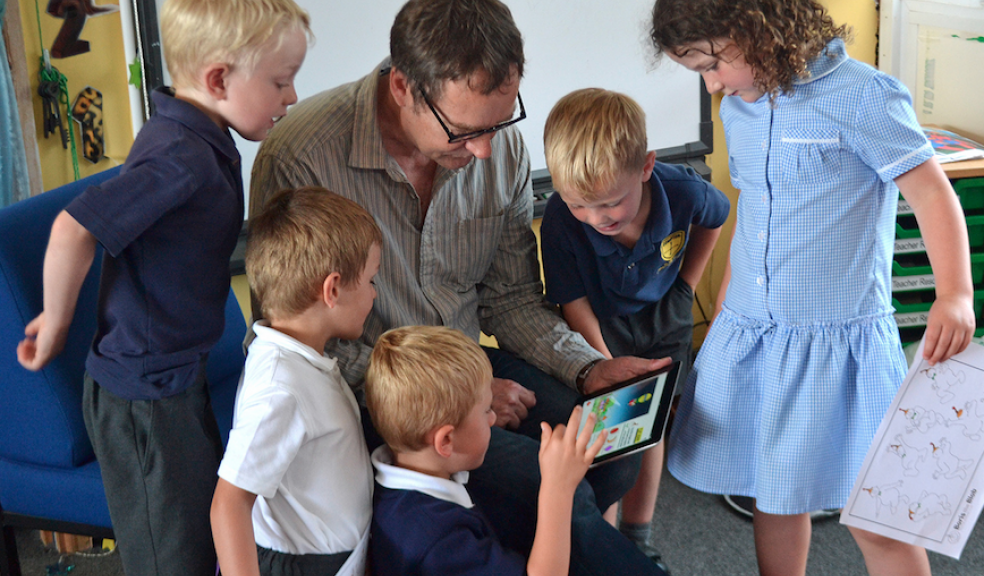
30-year-old character brought to life
A children’s cartoon character, created 30 years ago in sketch form as part of a college thesis, has finally been brought to stunning interactive life thanks to modern technology.
Boris the Blob was the brainchild of Plymouth graphic designer Mark Hannon while he was studying for an honours degree in scientific and technical graphics.
He created Boris as part of his studies into the use of cartoons in education and for the past three decades the Boris sketches have been tucked away in a drawer.
But the character is now set to become a firm favourite with young children. Combining the very latest in media technology and his creative art and design skills, Mark has produced an interactive downloadable eBook with narration and video buttons, as well as hidden sound effects and animation which children can discover as if by magic by touching the screen.
The 32-page book, Boris the Blob and his Shapes and Colours, is aimed at children aged 1-5. By touching the shapes and colours on the screen, audio gives them the name of the shapes and colours.
At the end of the book there are fun, educational games and the website has links to downloadable free ‘extras’ such as colouring sheets. In the story, Boris is a friendly, larger-than-life cartoon character who brings magical shapes and colours to a young girl, Molly, and her pet cat.
They go on a night-time adventure which takes them to the moon and back in a hot air balloon. On their journey they return the shapes – such as triangular roofs from houses and circular wheels from cars – dropping them back to Molly’s town.
When Molly wakes up feeling worn out, she begins to remember her adventures with Boris but she wonders if it was all a dream. As the story progresses, everything slots into place – just like the shapes. “It’s using a friendly character to get the educational message across in a fun way,” said Mark.
“It teaches children about shapes and colours and their place in the world; how they work in the environment.
And it does it in an interactive way that enables them to use their own creativity and imagination.
“Because there are hidden sounds and magic animation, they can dip in and out of the book lots of times and they can carry on exploring the pages, so it’s an experience rather than just a book.”
The book has been a year in the making for Mark, who has spent all his spare time on the project. The process involved pencil sketching; inking in and scanning; importing into illustration programmes (Photoshop and Illustrator); and creating 2d and 3d animations (After Effects and Cinema 4d), including using state of the art 3d motion dynamics physics engine.
Finally audio and interactivity (App Studio and iBooks Author) and computer games (Webkit HTML programming) were added. For the character of Molly, he used his eight-year-old daughter Ines for visual reference and voiceover.
Ines has also provided feedback about the story and the book’s rhymes: “She loves it, but then again she’s probably biased!” For more objective feedback, Mark projected the book onto a whiteboard at Compton Church of England Primary School in Plymouth, where there was an enthusiastic response from the 60 children aged 4-5: “The group all sat happily for the duration and were fully absorbed and actively involved in the storyline,” said Mark.
“They loved the sights and sounds throughout the book and they all joined in with cheering the children who were selected to play the games at the back of the book.” Vicki Watts, class teacher and specialist leader of education, says the book could be used widely in schools as well as by parents at home: “We would use this as a teaching aid during maths sessions. I highly recommend it to parents, teachers and children.”
Colleague Jo Stapleton, class teacher and Plymouth leader of education, agreed: “It captured our children’s attention throughout. They enjoyed engaging with the different activities on each page. The sounds and visual effects were brilliant.”
Feedback from the children ranged from “throwing the shapes down was my favourite bit,” and “I liked the way he changed colour. It was incredible”, to “I liked the bit where you played puzzles at the end because it helped me to remember shapes” and “the little girl wants to play with shapes.
I am going to look at shapes in my bedroom.” A group of 12 younger children aged 3-4 at Compton Pre-school also enjoyed ‘meeting’ Boris. Special educational needs co-ordinator Samantha Beal said: “The lack of wriggling was testament to their enjoyment. It was an exciting way to focus on what can be quite a dry subject and was a good fit for the pre-school age child, as many are still learning colours and shapes.
Younger children could be supported by an adult. However, older pre-school children could access this independently.”
Mark also believes the interactive nature of the book could help children with learning difficulties such as autism: “It might be good for children who like to touch and hear things, enjoy rhyming verse, and who respond well with interactivity.” Boris the Blob is initially available as an Apple iBook or an App, downloadable from iTunes and the Appstore. Visit the website for more information. www.boristheblob.co.uk











